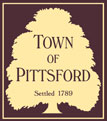Kolaneka Farms
Some people pronounce it KO LAN E KA and some say KO LAN E KA , but whatever way it is pronounced, it was a beautiful farmstead on Mitchell Road.
The history of the Guernsey-Mitchell property dates back to the early 1800's when James K. Guernsey purchased about 290 acres of land. On it he raised crops, cattle, and horses. We have a map showing what crops were raised in what area of the farm, where the trees grew in the orchard, and where the horse track was located.
When the canal was completed in 1825, General Lafayette made a visit to Rochester. There was no equipment fine enough to bear that famous visitor and so the carriage of James Guernsey was called into service. Also when Daniel Webster visited, he rode in that same grand coach. This gives one some idea of how important and wealthy was James K. Guernsey.
After Guernsey died, his son, Duane inherited the property. Duane built a very elaborate farmhouse on the property on the site of the current home. We have no records of the kind of home James had built, but the Italian villa style home for Duane has been described in infinite detail. It had columns extending across the front of the house and on one side they were very intricate. The windows had a Tudor hood molding over the top of each one. The roofline was broken by dormers, and the cupola had a gabled roof complete with an ornate decorative finial. The front entrance hall had a stairway to the left with the dining room behind it and a double parlor that opened up to the right. It was important in large homes to have a double parlor for use in weddings, funerals with place for the casket, and for other important and special occasions. The kitchen was set off in the left wing and between the kitchen and front hall was the room in which Mr. Guernsey conducted his farm business. The front entrance was used strictly for social events and business associates were not to enter there.
There were five bedrooms upstairs and the third floor housed quarters for the servants. The maid lived in quarters over the kitchen.
Besides the estate house, there was a large brood mare barn located between the main house and the canal. The barn, which remains today, has been converted into a private, charming home. The barn dates back to 1860 and was designed by a well-known architect, A.J. Downing. It has a plate roof and a cupola similar to the main house but not as ornate. The cupola was designed to be serviceable. It had slats to draw in air to prevent simultaneous combustion of the hay stored on the second floor. The first floor was used to house the young horses. The lane that ran in front of the estate was known as Guernsey Lane and later changed to Mitchell Road.
The house, barn, and 283 acres of land were sold to Francis B. Mitchell. He was a wealthy man who wanted a place in the country where he could raise and race trotting horses and just relax when he wanted to get away from his "town home". His main home was in Rochester, where he lived with his sister, Laura, who married William S. Kimball of Kimball Tobacco Company.
Francis owned a newspaper company and was the publisher. This paper was not financially successful and was subsidized by Laura. He and Laura had a brother, Guernsey Mitchell, who was a sculptor. In 1851 Mrs. Kimball commissioned her brother to design a statue for the top of the Kimball Tobacco Company which was located where the Blue Cross Arena is now. This statue was known as Mercury and now resides atop what was until recently the Lawyers Co-operative Building.
Francis had purchased the estate as a place for relaxation and enjoyment. He had many farm hands and a personal chauffeur who brought him from his home in Rochester to the Lane by horse and buggy. Francis made many improvements to the farm due to his love of horses and racing. He was inspired to create a larger race track which he built near the corner of Marsh Road and Route 31, very near where the Post Office is now located. A newspaper article in the Brighton Pittsford Post, noted that "this track is conceived by horsemen throughout the country to be one of the most perfect half-mile ovals in the US”. It was built by Francis B. Mitchell so that his harness horses might take records without journeying from their training grounds.
There were other buildings located on the estate. Among them were a barn near the track, a small tavern near the road, and a chicken coop located at 28 Mitchell Road. The house that Duane Guernsey built burned in 1918 and the present home on Mitchell Road was built in 1922.

 Copyright © 2021 Town of Pittsford.
Copyright © 2021 Town of Pittsford.